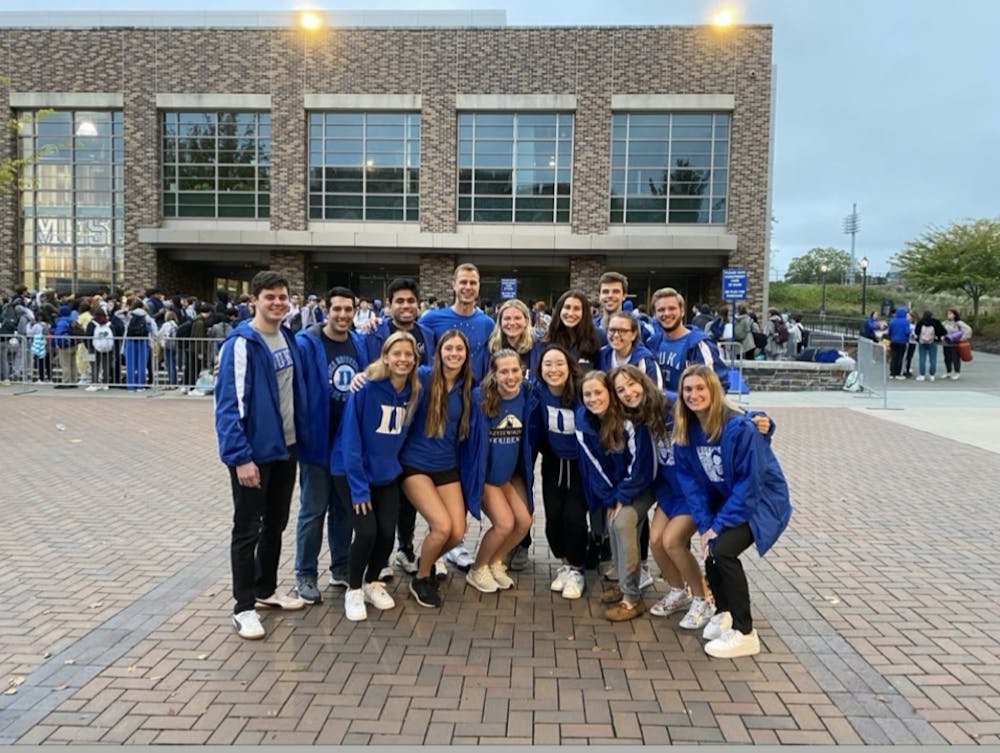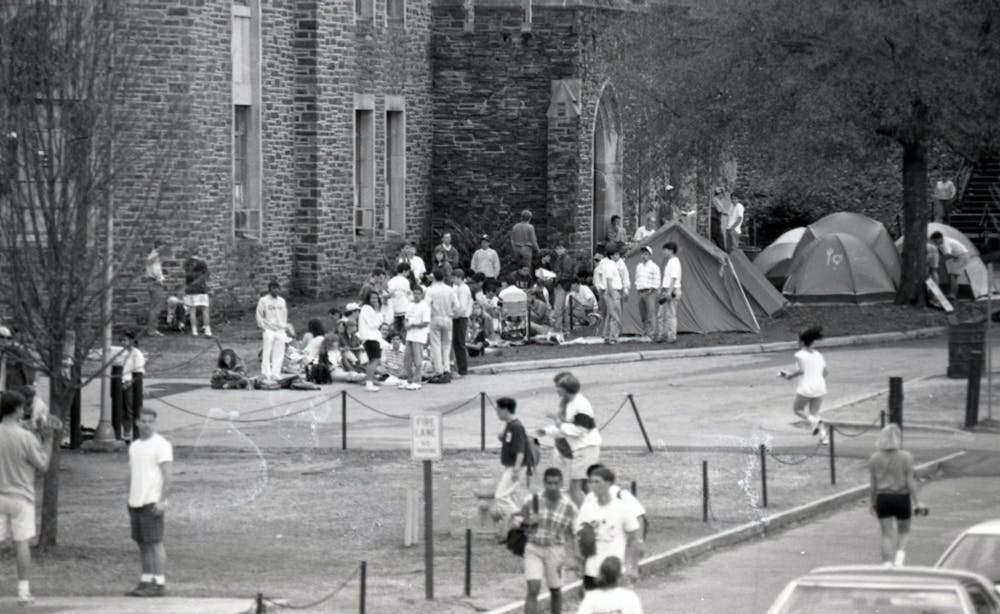It’s gameday for Duke men's basketball in Krzyzewskiville. Hundreds of students have gathered on the lawn, holding their spots in line as they eagerly wait for the doors to Cameron Indoor Stadium to open. They know that the building doesn’t have much space in the student section, and everyone’s looking for a way inside. K-Ville is littered with evidence that the Cameron Crazies have been there for hours: sleeping bags, camp chairs, snacks and lawn games.
Even among all this commotion, when gametime arrives, all of the students will line up in order, wristbands and student IDs at the ready, for a smooth and organized entry into Cameron. And we have line monitors to thank for managing the chaos.
Line monitors are a group of Duke students responsible for managing gameday lines and tenting. They make sure students stay in line before games and help fill the student section before tipoff.
Over the years, the position has grown with the basketball program’s reputation. The line monitors now play a crucial role in nurturing the revered tradition of tenting before UNC-Duke matchups in Cameron.
The streamlined K-Ville rules that students take for granted today are actually recent history. Up until the 1980’s, line monitors and tent checks didn’t exist at Duke—the tenting process from that early era would appear entirely foreign to current Cameron Crazies.
The genesis of line monitors
Jose Isasi, Trinity ‘89, claims to be the person responsible for creating the position of line monitor. As he tells it, the role grew out of the rising hype around an up-and-coming Duke basketball program.
When Duke went all the way to the NCAA Division I men’s basketball championship in Isasi’s first year, student excitement was at an all time high that season.
“There were tents out there for every game of the [Atlantic Coast Conference] season,” Isasi said.

As the season went on, student leaders in the Associated Students of Duke University, the precursor to Duke Student Government, became worried about safety in K-Ville.
“[At] the Carolina game my freshman year, we had some incidents where the line started compressing before the doors got open … we just became concerned that something bad was going to happen,” Isasi said.
Isasi, who was the chair of the Building, Grounds and Athletic Affairs committee of ASDU, came up with a policy to more formally track who was in line before games.
After talking to tenters, he realized that the policy should “reward the people who had the commitment,” so he devised tent checks. Tent checks helped prevent people from dropping tents and leaving, or from setting up extra empty tents to take up more space in line.
During the first year, he recruited line monitors exclusively from the student government, choosing students who were “dependable and thick-skinned.” In those early stages, there were five line monitors per year at most, according to Isasi.
“No one viewed [being a line monitor] as a privilege or an honor,” Isasi said. “We caught a lot of grief, actually, from the the hardcore tenters … you know, there are some very creative names that would be chanted our way.”

Isasi said that he could only get people to volunteer as monitors because they could get into Cameron first, entering even before students who were lined up.
Get The Chronicle straight to your inbox
Sign up for our weekly newsletter. Cancel at any time.
The tenters, however, weren’t thrilled to give up their front row seats.
“Our authority came from us negotiating with them and letting [tenters] know, ‘They're gonna let us in first. But we're not going to take the prime seats,’” Isasi said. “And with that trade off, everyone was okay.”
The tenting tradition itself was just starting to gain traction during Isasi’s tenure as head line monitor. Lines started forming much later than they do now; they began only about a week prior to the UNC game and a day before other ACC games.
“There was no six week [tenting period], and there was no Black tenting. There was no rule,” Isasi said.
Line monitors today
Today, line monitors are an exclusive group, picked carefully for their dedication to Duke basketball through a rigorous selection process.
Prospective line monitors must go through a written application, which is assessed to see which applicants are passionate about K-Ville, according to senior Daniel Behrens, a vice president of tenting. After this, remaining applicants are interviewed. Ultimately, about 30 applicants are selected to be line monitors.

Line monitors’ responsibilities are a lot more structured now. According to senior line monitor Thomas Williford, line monitors’ non-UNC gameday responsibilities are split into three different groups.
The first part of the day involves registering each group, handing out wristbands and keeping order in line. During the second part, which is the “little purgatory area about to get to the heaven of Cameron Indoor,” line monitors check wristbands, ensure groups are standing in order and get students to swipe their student IDs to enter Cameron.
The infamous last part of line monitors’ gameday is “Squish”: “To make sure they get as many people into Cameron as possible, and make sure people turn sideways,” Williford said.
“It’s not something that anyone enjoys doing,” Behrens said. “But it's a necessary evil for sure.”
Line monitors are always looking to improve the tenting experience, and the position will continue to evolve.
Williford mentioned that the line monitors would have a tent in K-Ville this season for the first time.
“People have the perception that line monitors don't do as much as tenters, but they do more than any Black tenter could imagine,” he said, noting that this new policy would help alleviate this concern.
Ben Randoing, a senior and vice president of tenting, said the line monitors have pushed for greater inclusivity.
“[We’re] trying to have more events and make it more of a community that's more frequent, more year-round,” he said. “[We want] all majors, all backgrounds, everyone just to come experience it. It's really cool.”
Behrens explained that the line monitors are trying to factor in more outdoor events during tenting to facilitate camaraderie in a COVID-modified tenting season.
“With losing Black tenting, we’re losing the part that builds the most community,” he said. “We're going to try and make up for that … the goal is to be able to put on a lot more stuff that builds the K-Ville community.”
The line monitor position has transformed from a compulsory, jeer-inspiring task to a privilege and a coveted spot. Beyond this, current line monitors emphasize that they’re a close-knit group.
“What really drew me to [becoming a line monitor] was the community that they would help foster,” Randoing said. “The fundamental part of the position is trying to maintain the integrity of K-Ville. We're sort of just facilitating.”
Anisha Reddy is a Trinity junior and a senior editor of The Chronicle's 118th volume.

